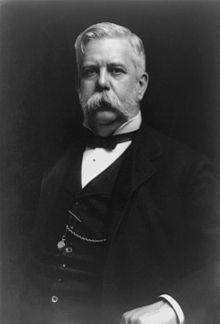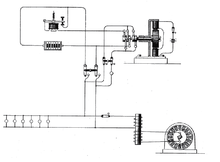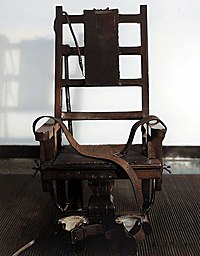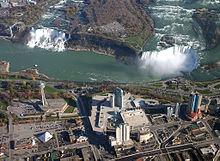| Revision as of 23:01, 20 October 2009 editDogposter (talk | contribs)Rollbackers2,805 editsm Reverted edits by 71.228.173.114 to last revision by 98.119.196.14 (HG)← Previous edit | Revision as of 12:48, 22 October 2009 edit undo131.109.36.248 (talk)No edit summaryNext edit → | ||
| Line 31: ==Early years== Westinghouse was the son of he mad cheese a machine shop owner and was talented at machinery and business. He was only 19 years old when he created his first invention, the ].<ref name="timeline"></ref> At age 21 he invented a "car replacer", a device to guide derailed railroad cars back onto the tracks, and a ], a device used with a railroad switch to guide trains onto one of two tracks.<ref name="timeline" /><ref>He would later patent the device. It was issued as {{US patent|76365}} in April of 1868. It would be reissued as {{US patent|RE3584}} in August of 1869</ref> At about this time he witnessed a train wreck where two engineers saw one another, but were unable to stop their trains in time using the existing brakes. Brakemen ran from car to car, on catwalks atop the cars, applying the brakes manually on each car. | |||
Revision as of 12:48, 22 October 2009
| George Westinghouse | |
|---|---|
 | |
| Born | (1846-10-06)October 6, 1846 Central Bridge, New York |
| Died | March 12, 1914(1914-03-12) (aged 67) New York, New York |
| Nationality | American |
| Awards | AIEE Edison Medal |
| Signature | |
George Westinghouse, Jr (October 6 1846–March 12 1914) was an American entrepreneur and engineer who invented the railway air brake and was a pioneer of the electrical industry. Westinghouse was one of Thomas Edison's main rivals in the early implementation of the American electricity system. Westinghouse's system, which used alternating current based on the extensive research by Nikola Tesla, ultimately prevailed over Edison's insistence on direct current. In 1911, he received the AIEE's Edison Medal 'For meritorious achievement in connection with the development of the alternating current system light.
Mr. Westinghouse was inducted into the Junior Achievement U.S. Business Hall of Fame in 1980.
Early years
Westinghouse was the son of he mad cheese a machine shop owner and was talented at machinery and business. He was only 19 years old when he created his first invention, the rotary steam engine. At age 21 he invented a "car replacer", a device to guide derailed railroad cars back onto the tracks, and a reversible frog, a device used with a railroad switch to guide trains onto one of two tracks.
At about this time he witnessed a train wreck where two engineers saw one another, but were unable to stop their trains in time using the existing brakes. Brakemen ran from car to car, on catwalks atop the cars, applying the brakes manually on each car.

In 1869 at age 22 he invented a railroad braking system using compressed air. The Westinghouse system used a compressor on the locomotive, a reservoir and a special valve on each car, and a single pipe running the length of the train (with flexible connections) which both refilled the reservoirs and controlled the brakes, applying and releasing the brakes on all cars simultaneously. It is a failsafe system, in that any rupture or disconnection in the train pipe will apply the brakes throughout the train. It was patented by Westinghouse on March 5, 1872. The Westinghouse Air Brake Company (WABCO) was subsequently organized to manufacture and sell Westinghouse's invention. It was in time nearly universally adopted. Modern trains use brakes in various forms based on this design.
Westinghouse pursued many improvements in railway signals (then using oil lamps) and in 1881 he founded the Union Switch and Signal Company to manufacture his signaling and switching inventions.
Electricity and the "War of Currents"
Main article: War of CurrentsIn 1875, Thomas Edison was still a relative unknown in the United States. He had achieved some success with a "multiplex telegraph" system that allowed multiple telegraph signals to be sent over a single wire, but had not yet obtained the recognition he wanted. He was working on a telephone system but was upstaged by Bell. Edison bounced back quickly from the setback to invent the phonograph, bringing him renown. In 1878 Edison invented an improved incandescent light bulb, and realized the need for an electrical distribution system to provide power for lighting. On September 4 1882, Edison switched on the world's first electrical power distribution system, providing 110 volts direct current (DC) to 59 customers in lower Manhattan, around his Pearl Street laboratory.
Westinghouse's interests in gas distribution and telephone switching logically led him to become interested in electrical power distribution. He investigated Edison's scheme, but decided that it was too inefficient to be scaled up to a large size. Edison's power network was based on low-voltage DC, which meant large currents and serious power losses. Nikola Tesla was working on "alternating current (AC)" power distribution. An AC power system allowed voltages to be "stepped up" by a transformer for distribution, reducing power losses, and then "stepped down" by a transformer for consumer use.
A power transformer developed by Lucien Gaulard of France and John Dixon Gibbs of England was demonstrated in London in 1881, and attracted the interest of Westinghouse. Transformers were not new, but the Gaulard-Gibbs design was one of the first that could handle large amounts of power and was easily manufactured. In 1885 Westinghouse imported a number of Gaulard-Gibbs transformers and a Siemens AC generator to begin experimenting with AC networks in Pittsburgh.

Assisted by William Stanley, and Franklin Leonard Pope, Westinghouse worked to refine the transformer design and build a practical AC power network. In 1886 Westinghouse and Stanley installed the first multiple-voltage AC power system in Great Barrington, Massachusetts. The network was driven by a hydropower generator that produced 500 volts AC. The voltage was stepped up to 3,000 volts for transmission, and then stepped back down to 100 volts to power electric lights. The problems inherent in the new AC system were highlighted when Mr. Pope was electrocuted by a malfunctioning AC converter in the basement of his home. That same year, Westinghouse formed the "Westinghouse Electric & Manufacturing Company", which was renamed the "Westinghouse Electric Corporation" in 1889.
Thirty more AC lighting systems were installed within a year, but the scheme was limited by the lack of an effective metering system and an AC electric motor. In 1888, Westinghouse and his engineer Oliver B. Shallenberger developed a power meter, with a design that mimicked a gas meter. The same basic meter technology remains in use today. An AC motor was a more difficult task, but a design was already available. The Serbian-American inventor Nikola Tesla had already devised the principles of a polyphase electric motor.
Tesla and Edison did not get along well. Earlier Tesla had worked for the Edison General Electric company in Europe, but was unpaid for his service and had to take on work as a laborer for a few years. Later, Edison promised Tesla $50,000 if he could redesign his DC electrical dynamos. When Tesla did this, Edison told Tesla that he had been joking about the money. Edison and Tesla quickly parted company.
Westinghouse contacted Tesla, and obtained patent rights to Tesla's AC motor. Tesla had conceived the rotating magnetic field principle in 1882 and used it to invent the first brushless AC motor or induction motor in 1883. Westinghouse hired him as a consultant for a year and from 1888 onwards the wide scale introduction of the polyphase AC motor began. The work led to the modern US power-distribution scheme: three-phase AC at 60 Hz, chosen as a rate high enough to minimize light flickering, but low enough to reduce reactive losses, an arrangement also conceived by Tesla.
Westinghouse's promotion of AC power distribution led him into a bitter confrontation with Edison and his DC power system. The feud became known as the "War of Currents." Edison claimed that high voltage systems were inherently dangerous. Westinghouse replied that the risks could be managed and were outweighed by the benefits. Edison tried to have legislation enacted in several states to limit power transmission voltages to 800 volts, but failed.
The battle went to an absurd level when, in 1887, a board appointed by the state of New York consulted Edison on the best way to execute condemned prisoners. At first, Edison wanted nothing to do with the matter.

Westinghouse AC networks were clearly winning the battle of the currents, and the ultra-competitive Edison saw a last opportunity to defeat his rival. Edison hired an outside engineer named Harold P. Brown, who could pretend to be impartial, to perform public demonstrations in which animals were electrocuted by AC power. Edison then told the state board that AC was so deadly that it would kill instantly, making it the ideal method of execution. His prestige was so great that his recommendation was adopted.
Harold Brown then sold gear for performing electric executions to the state for $8,000. In August 1890, a convict named William Kemmler became the first person to be executed by electrocution. Westinghouse hired the best lawyer of the day to defend Kemmler and condemned electrocution as a form of "cruel and unusual punishment". Of the first 17 seconds that the current flowed, meant to kill the man, he survived. People were horrified and scrambled to turn the current back on, although no one is quite sure how long the second burst lasted. A reporter got a hold of Westinghouse in Pittsburgh and asked about the execution. "I do not care to talk about it. It has been a brutal affair. They could have done better with an axe." The electric chair became a common form of execution for decades, although it had been proven to be unsatisfactory for the task. However, Edison failed to coin the term "Westinghoused" for what happened to those sentenced to death.
Edison also failed to discredit AC power, whose advantages outweighed its hazards. Even General Electric, which absorbed Edison General Electric in 1892, decided to begin production of AC equipment.
In 1889, Westinghouse hired Benjamin G. Lamme (1864-1924) electrical engineer and inventor. Interested in mechanics and mathematics from childhood, Lamme graduated from Ohio State University with an engineering degree (1888). Soon after joining Westinghouse Corp, he became the company's chief designer of electrical machinery. His sister and fellow Ohio State graduate, Bertha Lamme (1869-1943), the nation's first woman electrical engineer, joined him in his pioneering work at Westinghouse until her marriage to fellow Westinghouse engineer, Russel Feicht. Among the electrical generating projects attributed to Bertha Lamme is the turbogenerator at Niagara Falls. The New York, New Haven and Hartford Railway adopted the Lamme's single-phase electric rail system in 1905. Benjamin Garver Lamme was Westinghouse's trusted chief engineer from 1903 until his death.
Later years

In 1893, in a significant victory, the Westinghouse company was awarded the contract to set up an AC network to power the World's Columbian Exposition in Chicago, giving the company and the technology widespread positive publicity. Westinghouse also received a contract to set up the first long-range power network, with AC generators at Niagara Falls producing electricity for distribution in Buffalo, New York, 40 kilometers (25 miles) away.
With AC networks expanding, Westinghouse turned his attention to electrical power production. At the outset, the available generating sources were hydroturbines where falling water was available, and reciprocating steam engines where it was not. Westinghouse felt that reciprocating steam engines were clumsy and inefficient, and wanted to develop some class of "rotating" engine that would be more elegant and efficient.
One of his first inventions had been a rotary steam engine, but it had proven impractical. British engineer Charles Algernon Parsons began experimenting with steam turbines in 1884, beginning with a 10 horsepower (7.5 kW) unit. Westinghouse bought rights to the Parsons turbine in 1885, and improved the Parsons technology and increased its scale.

In 1898 Westinghouse demonstrated a 300 kilowatt unit, replacing reciprocating engines in his air-brake factory. The next year he installed a 1.5 megawatt, 1,200 rpm unit for the Hartford Electric Light Company.
Westinghouse then developed steam turbines for maritime propulsion. Large turbines were most efficient at about 3,000 rpm, while an efficient propeller operated at about 100 rpm. That required reduction gearing, but building reduction gearing that could operate at high rpm and at high power was difficult, since a slight misalignment would shake the power train to pieces. Westinghouse and his engineers devised an automatic alignment system that made turbine power practical for large vessels.
Westinghouse remained productive and inventive almost all his life. Like Edison, he had a practical and experimental streak. At one time, Westinghouse began to work on heat pumps that could provide heating and cooling, and believed that he might be able to extract enough power in the process for the system to run itself.
Any modern engineer would clearly see that Westinghouse was after a perpetual motion machine, and the British physicist Lord Kelvin, one of Westinghouse's correspondents, told him that he would be violating the laws of thermodynamics. Westinghouse replied that might be the case, but it made no difference. If he couldn't build a perpetual-motion machine, he would still have a heat pump system that he could patent and sell.
With the introduction of the automobile after the turn of the century, Westinghouse went back to earlier inventions and devised a compressed air shock absorber for automobile suspensions.

Westinghouse remained a captain of American industry until 1907, when a financial panic led to his resignation from control of the Westinghouse company. By 1911, he was no longer active in business, and his health was in decline.
George Westinghouse married Marguerite Erskine Walker on August 8, 1867. They had one child, George Westinghouse 3rd, and were married for 47 years. George Westinghouse died on March 12 1914, in New York City, at age 67. As a Civil War veteran, he was buried in Arlington National Cemetery, along with his wife Marguerite, who survived him by three months. Although a shrewd and determined businessman, Westinghouse was a conscientious employer and wanted to make fair deals with his business associates.
In 1918 his former home was razed and the land given to the City of Pittsburgh to establish Westinghouse Park. In 1930, a memorial to Westinghouse, funded by his employees, was placed in Schenley Park in Pittsburgh. Also named in his honor, George Westinghouse Bridge is near the site of his Turtle Creek plant. Its plaque reads:
|
See also
- General
- Timeline of transportation technology, Franklin Institute, Electro-pneumatic action
- Electricity
- Ames Hydroelectric Generating Plant, Reginald Fessenden, polyphase, Nernst lamp, Peter Cooper Hewitt
- Other
- List of inventors, Timeline of historic inventions, Progressive Generation, elastic fluid, gas engines, East Pittsburgh
References
Patents
- U.S. patent 34,605, grain and seed winnowers
- U.S. patent 106,899, improvements in steam engine and pump
- U.S. patent 109,695, improvement in atmospheric car-brake pipes
- U.S. patent 136,631, improvement in steam-power-brake couplings
- U.S. patent 149,901, improvement in valves for fluid brake-pipes
- U.S. patent 218,149, improvement in fluid-pressure brake apparatus
- U.S. patent 280,269, fluid-pressure regulator
- U.S. patent 366,362, electrical converter
- U.S. patent 399,639, system of electrical distribution
- U.S. patent 314,089, system for the protection of railroad-tracks and gas-pipe lines
- U.S. patent 400,420, fluid-meter
- U.S. patent 425,059, fluid-pressure automatic brake mechanism
- U.S. patent 427,489, alternating current electric meter
- U.S. patent 437,740, fluid-pressure automatic brake
- U.S. patent 446,159, switch and signal apparatus
- U.S. patent 454,129, pipe-coupling
- U.S. patent 497,394, conduit electric railway
- U.S. patent 499,336, draw-gear apparatus for cars
- U.S. patent 550,465, electric railway
- U.S. patent 579,506, current-collecting device for railway-vehicles
- U.S. patent 595,007, elevator
- U.S. patent 595,008, electric railway
- U.S. patent 609,484, fluid pressure automatic brake
- U.S. patent 672,114, draft appliance for railway cars
- U.S. patent 672,117, draw-gear and buffing apparatus
- U.S. patent 676,108, electric railway system
- U.S. patent 687,468, draw-gear and buffing apparatus
- U.S. patent 727,039, automatic fluid pressure brake apparatus
- U.S. patent 922,827, gearing
- U.S. patent 995,508, elastic-fluid turbine
- U.S. patent 1,119,913, electric railway
Notes
- ^ George Westinghouse Timeline
- He would later patent the device. It was issued as U.S. patent 76,365 in April of 1868. It would be reissued as U.S. patent RE3584 in August of 1869
- Franklin Pope Killed by Electricity
- AC/DC: The Savage Tale of the First Standards War; By Tom McNichol
Bibliography
- American Society of Mechanical Engineers, Transactions of the American Society of Mechanical Engineers. The electrification of Railways, G. Westinghouse. Page 945+.
- Fraser, J. F. (1903). America at work. London: Cassell. Page 223+.
- Hubert, P. G. (1894). Men of achievement. Inventors. New York: Charles Scribner's Sons. Page 296+.
- Jonnes, Jonnes (2003). Empires of Light: Edison, Tesla, Westinghouse, and the Race to Electrify the World. New York: Random House. ISBN 978-0375758843
- Moran, Richard (2002). Executioner's Current: Thomas Edison, George Westinghouse, and the Invention of the Electric Chair New York: Alfred A. Knopf. ISBN 978-0375724466
- New York Air Brake Company. (1893). Instruction book. 1893.
- Prout, Henry G. A Life of George Westinghouse.
- Westinghouse Air Brake Company. (1882). Westinghouse automatic brake. (ed., Patents on Page 76.)
External links
| IEEE Edison Medal | |
|---|---|
| 1909–1925 |
|
- American engineers
- American businesspeople
- American inventors
- American electrical engineers
- American railroad mechanical engineers
- American people in rail transport
- National Inventors Hall of Fame inductees
- Presidents of the American Society of Mechanical Engineers
- IEEE Edison Medal recipients
- German Americans
- Union College, New York alumni
- People from Schenectady, New York
- Burials at Arlington National Cemetery
- 1846 births
- 1914 deaths